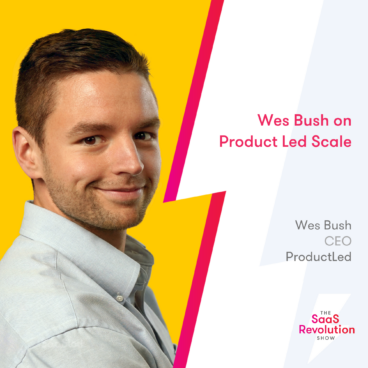In this episode of the SaaS Revolution Show, Wes Bush, Founder and CEO of ProductLed, joins our host Alex Theuma to share his thoughts on the future of product-led growth—product-led scale.
Watch or listen below or read on for key takeaways.
There are always trends in SaaS.
Every few years a new concept or technology dominates headlines, underpins event agendas, and leads the next wave of product innovation.
Right now, it’s generative AI but in the years prior, it was product-led growth (PLG) shaking things up.
It wasn’t new, people were already doing it. But then OpenView gave it a name and people like Wes set out to help companies generate product-led revenue more effectively and it became top of the SaaS agenda.
But where is PLG now? And what impact is AI innovation having on product-led businesses?
Our CEO Alex Theuma put this to ProductLed Founder and CEO Wes Bush in their chat on the podcast. And it’s safe to say, PLG is just getting started. There was a lot to cover, so much so that he’s written a new book on it.
He discussed how we’re actually at a time where businesses need to go beyond PLG and become product-led organizations with PLG motions. This sentiment is shared by other leaders Alex has spoken to and marks an interesting time for product-led SaaS.
Why PLG is only half of the story
Amidst the PLG virality, lots of new market entrants started out product-led. But it also left B2B businesses, who’d built their company around sales-led processes, looking to expand their total-addressable market (TAM) with this new go-to-market (GTM) motion.
In doing so, founders cited the giants of PLG, like Miro and Slack, and implemented what Wes referred to as product-led tools – like a free trial, freemium model, or transparent pricing across their website.
Wes discussed how, after doing this, many founders tell him that PLG doesn’t work – but it’s because they’ve only solved half the problem. It’s missing the underlying environment that enables PLG to succeed. This includes: an onboarding flow that reduces time to value, a strategy for converting free users to paying customers, and a seamless cancellation flow that prevents churn (like this one from Canva).
To scale PLG you need a product-led org (PLO)
It’s Wes’ view that companies need to shift from implementing PLG to integrating it across an entire business. Especially if the aim is to scale a product-led business to £10M ARR and beyond.
So, what actually is a product-led organization?
It’s a company that’s overarching strategy is designed to support PLG. It’s one that’s laser focused on its users and has the team, data, and processes to effectively support a PLG motion.
Esben Friis-Jensen Co-Founder and Chief Growth Officer at Userflow also spoke to this on the podcast. He used an example about companies who receive a number of support requests for the same product issue. In a traditional B2B SaaS company, the solution would be to hire more team members to deal with these requests.
In a product-led organization, it’s to fix or optimize the product feature first.
It’s also leveraging the power of AI. Wes used a similar example – this time to illustrate how AI enabled support can effectively provide solutions for high volumes of requests from free users.
4 characteristics of product-led organizations
The move to product-led organizations makes for interesting discussion about the structure of B2B SaaS teams and the importance of product departments.
Sherrie Fernandes, VP Product Marketing and User Experience at Globalization Partners (G-P), she shared what 4 key characteristics make $300M ARR company G-P product-led.
1. Customer centric: G-P places the customer at the center of everything it does. Its product development and innovation teams are driven by customer feedback.
2. Product-first mindset: Teams use that feedback to deliver high quality products that meet customers’ needs and differentiate them from competitors.
3. Data driven decision making: G-P collects and analyzes data on customer behavior, market trends, and product performance to inform product decisions.
4. Continuous improvement: G-P uses agile methodologies to test, learn, and iterate on its product development cycle
AI might be making headlines but PLG is still making waves in B2B SaaS. It’s more mature now and requires company level strategies to work at scale.
We’ll be following closely, listening to leaders in the space, and watching the companies that rise to the challenge.
If you’re interested in hearing more on this, Wes and Esben will be speaking on it at SaaStock USA in May. Wes will share how to scale a product-led business past 8 figures – including nine core components that every founder should be looking to implement. And Esben will discuss how his PLG startup Userflow got acquired in a multimillion dollar deal with Beamer.
If you want similar tips and are looking to achieve success all year round, check out the SaaStock Founder Membership:
A private community of ambitious SaaS founders scaling to $10MM ARR. Get a support network of peers, connect with likeminded founders around the globe, and learn proven strategies from industry experts. Apply now to scale up your SaaS.
Want to join the pioneers at the forefront of The SaaS revolution? Subscribe to our SaaStock Blueprint newsletter to get exclusive content, receive actionable insights and create your Rocketship SaaS.





